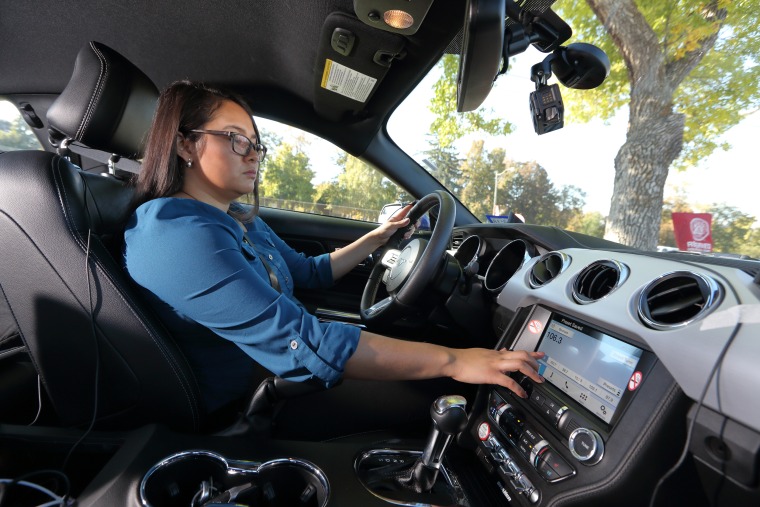A new AAA car safety study suggests that tech-laden “smart” cars are too distracting, which can undermine efforts to keep roadways safe, especially when those getting behind the wheel are aged 55 and over.
Cars today boast all kinds of bells and whistles unavailable to previous generations — everything from seat warmers to windshield wipers that automatically turn on when it rains, to sketch pads that enable drivers to doodle as they drive.
However, according to the findings of the study, conducted by researchers at the University of Utah and carried out for the AAA Foundation for Traffic Safety, older drivers find many new smart car features to be more demanding, and confusing, than do younger drivers.
“The technology we’re putting in cars today are unsafe for all of us to use, especially for older adults,” said Jake Nelson, AAA Director of Traffic Safety Advocacy and Research. “Our advice to consumers is that just because technology is built into your car doesn’t mean that it’s safe to do those things.”
In the study, drivers were divided into two groups, a younger group aged 21 to 36, and an older group aged 55 to 75. Each driver was asked to drive a 2018 car equipped with a number of “smart” features, including navigation screens and voice activation controls.
Among the tasks drivers were asked to complete: sending a text message, programming music, programming a navigation system, and placing a call.
Overall, the study found, older drivers experienced higher levels of cognitive and visual demand, compared to younger drivers. These differences were even more pronounced for older drivers when completing any in-vehicle information system task, or IVIS. But the study found that older and younger drivers both found some tech features challenging and time consuming.
“Given the demands associated with IVIS tasks,” the study concluded, “drivers of all ages should use these infotainment technologies only for legitimate emergencies or urgent, driving-related purposes.”
“If I was driving that kind of car, I would probably put a napkin or blanket over that screen so that I could concentrate on driving,” said one study participant in his 70s.
David Strayer, a professor of cognition and neural science at the University of Utah and one of the study's authors, said the study confirms that, for many drivers, technology-laden vehicles have too much going on.
“We found older drivers, who, for the most part, are the consumers who have the resources to purchase these newer vehicles, are having more difficulty using these features than the 20- and 30-year-olds,” said Strayer.
“Smart cars are making us more distracted more of the time,” Strayer said. “The car is now becoming as complicated as a complex plane in many cases. You’ve got 200 buttons and all kinds of screens and voice commands.”
Paul Brown, a 71-year-old retired attorney who resides in Salt Lake City, is one of the drivers who took part in the study.
“It was a comedy of errors,” Brown said of the displays and lights that he was asked to respond to as he drove.
“I don’t need something that is going to do everything for me and distract me while I’m driving,” Brown said. “Quite frankly, when I was driving, I found myself feeling as if I was driving dangerously because of all of those distractions.”
Brown said he found the large display screen situated to the right of the steering wheel in the cars he drove for the study especially distracting.
“If I was driving that kind of car, I would probably put a napkin or blanket or something over that screen so that I could concentrate on driving the car,” Brown said, adding that he prefers older, simpler cars.
Strayer said display screens in smart cars were originally installed as “back-up cameras,” a safety feature that enables drivers to see an image of the rear of the vehicle while reversing. He said the same screens installed to enhance safety now are loaded with a myriad of displays — such as navigation, music, and climate controls — that can inhibit a driver’s overall safety.
“Those screens grew from simple three inch by five inch back-up displays to 17-inch monitors,” Strayer said. “Now they’re so big they’re the size of a desktop computer.”
Strayer said he’s particularly troubled that some features that were once easy to utilize in cars — like how to honk a horn or turn up or down the heat — are now difficult for many drivers to navigate.
Strayer’s recommendation: Consumers buying a car should make certain they know how the features on a car work before they drive a new vehicle off the lot.
“Oftentimes when people buy a car, they don’t fully test out all of those features. They don’t sit there and try out all of the infotainment system, all of that gadgetry. The consumer needs to be aware of what they’re buying.”
Nelson said making cars more user friendly for older drivers ultimately makes cars safer for everyone.
“If we can design a system to make it so that utilizing a car’s features is no more distracting than tuning your radio, if we can achieve that for the older adult driver, we can all benefit from that,” Nelson said.
